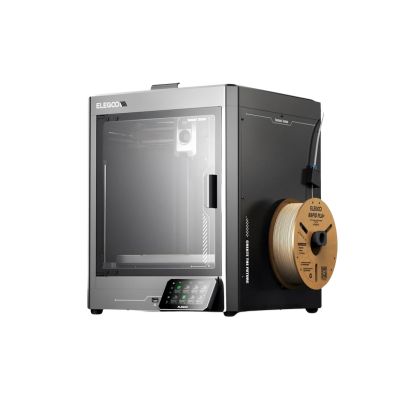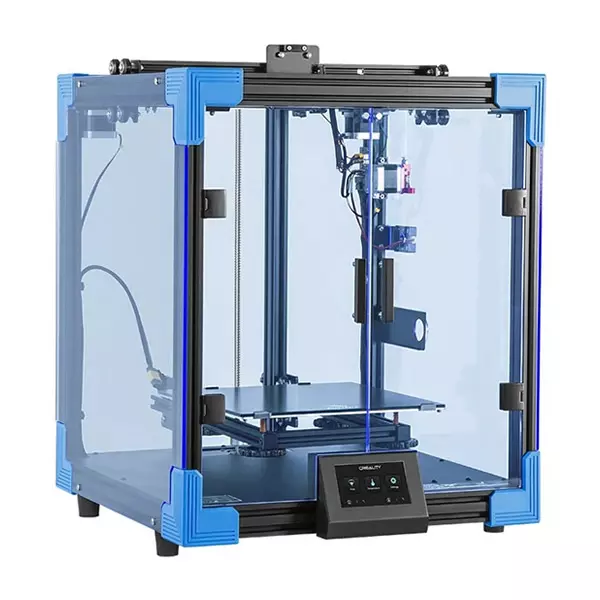Compare Centauri Carbon vs Ender 6
Comparison between the best 3D printers
Choose the best 3D printer at the best price. The cheapest 3D printers are here.
Buy a 3D printer here with 3D Fila.
 |
 |
|
| Model | Centauri Carbon |
Ender 6[BUY Ender 6] |
| Printing Material | Filament | Filament |
| Buy Filament for Elegoo Centauri Carbon | Buy Filament forCreality 3D Ender 6 | |
| Estimated price | $500,00 | $499,00 |
| Manufacturer | Elegoo | Creality 3D |
| Release Year | 2025 | 2020 |
| Print Volume [mm] | 256x256x256 | 250x250x400 |
| Printer Size [mm] | 500x500x600 | 495x495x650 |
| Weight [kg] | 17,5 | 22 |
| Power Loss Recovery | YES | YES |
| Enclosed printer | YES | YES |
| Bed Leveling | Automatic | Manual |
| Filament End Sensor | YES | YES |
| Bed type | Heated | Heated |
| Power supply system | Direct Drive | Bowden |
| Standard nozzle | 0,4 | 0,4 |
| Maximum Nozzle Temperature [°C] | 300 | 260 |
| Maximum Bed Temperature [°C] | 110 | 100 |
| Maximum printing speed [mm/s] | 500 | 150 |
| Filament holder | YES | YES |
| Camera for supervision | YES | YES |
| Recommended filaments | PLA, PETG, ABS, ASA, TPU, NYLON, CARBON FIBER | PLA, TPU, ABS, PETG |
| Recommended slicers | Elegoo Slicer, Orca Slicer | Cura, Simplify, Slic3r |
| Maximum Resolution [mm] | 0,1 | 0,1 |
| Processor | 32 bits | |
| Display | Touchscreen 4,3'' | Touchscreen TFT 4,3'' |
| Power Supply | 350 W | 24V / 504W |
| Connectivity | WiFi, SD, USB | SD / USB |
| Operating systems | Windows, Linux e Macbook | Windows, Mac, Linux |
| Date of registration in the system | 2025-02-10 | 2021-04-15 |
| Release date | 2025 | 2020 |
| Extra features | The Elegoo Centauri Carbon is a CoreXY 3D printer with an enclosed structure, direct drive extruder, and hardened steel components for abrasive materials. It features automatic bed leveling, a touchscreen, a filament cutting system, and an elongated nozzle designed to reduce clogs. It offers Wi-Fi connectivity for remote file transfer and runs on a Klipper-based firmware, providing advanced control and precise adjustments. | The Creality Ender 6 stands out in the world of 3D printers with its CoreXY system, offering fast and high-quality prints. With a robust design, it has acrylic panels to protect against air currents, optimizing the printing of materials that require higher temperatures. It features a generic Creality hotend, effective up to ~240°C. Its differentials include 10mm GATES belts, promoting stability at high speeds, and a 360W power supply for reliable performance. The machine also has an intuitive user interface through a 4.3-inch touchscreen. |
| Support for multiple colors and materials (AMS and CFS) | NO | NO |
Notes * |
||
| Cost-benefit | 8 / 10 | 7 / 10 |
| Hardware | 5.4 / 10 | 2.5 / 10 |
| Tela | . | . |
| Print volume | 4 / 10 | 4 / 10 |
| Performance | 4 / 10 | 1 / 10 |
| [BUY Ender 6] |
Conclusion |
| In conclusion, the Elegoo Centauri Carbon and the Creality Ender 6 are both compelling options within the realm of 3D printing, each catering to different user needs and preferences. The Centauri Carbon impresses with its newer release, advanced features, and robust performance capabilities. With a slightly larger print volume, automatic bed leveling, and a direct drive system, it is designed for users seeking precision and versatility, especially when working with a variety of materials, including more abrasive options. Its superior maximum nozzle and bed temperatures, along with a higher printing speed, position it well for demanding projects and larger prints. On the other hand, the Ender 6, while older, offers a solid performance with a reliable CoreXY mechanism and a proven design. It is a bit heavier and less advanced in terms of features like bed leveling and filament support options. However, its manufacturing stability and user-friendly interface have earned it a strong reputation within the community. From a cost-benefit perspective, while both printers are similarly priced, the Centauri Carbon offers enhanced capabilities that could justify a slight premium, making it a better option for users who plan to regularly experiment with different materials and require higher performance outputs. Conversely, the Ender 6 may appeal to budget-conscious users looking for a reliable, straightforward 3D printer without the latest bells and whistles. Ultimately, the choice between the two will hinge on individual preferences regarding features, ease of use, and intended applications. Users should weigh these factors against their specific printing needs to determine which printer aligns best with their requirements. |

